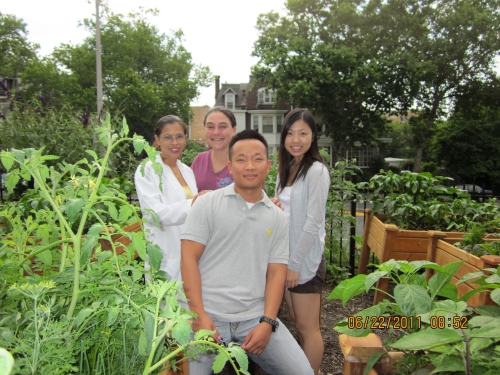How does your garden grow?

Andrea Baxter, Lorna Brod, Gary Yam and Nancy Miao, students from the accelerated second degree BSN program, assisted Philadelphia senior citizens this summer in growing a garden for health. “The community garden project was a great way to keep the neighborhood active and healthy,” says Yam.
A garden is a healthful thing, but as weekend warriors know, there can be hazards. Thanks to College of Nursing students at Villanova, there are Asian and African-American senior citizens who feel only the joy of their community garden in Philadelphia’s Logan section.
During the summer, students from the accelerated BSN program for adults with a college degree in another field worked with Assistant Professor Ruth McDermott-Levy, PhD, RN and the Nationalities Services Center (NSC) for their health promotion practicum. The 90 year old non-profit NSC provides social, educational and legal services to immigrants and refugees in the Greater Philadelphia area.
The garden is a project of the NSC so that the senior residents can participate in a meaningful outdoor activity of growing vegetables. Tara Schartzendruber-Landis, the Center’s Director, was instrumental in starting the garden and obtaining crops indigenous to the homelands of the immigrant senior citizens. Many of the Asian seniors were farmers in their home countries. They grow the vegetables to have at home, though there is also a garden for NSC to provide fresh produce for the Center’s lunches.
The nursing students spent time in the garden, and spoke with the seniors and NSC staff to determine what the greatest educational need was related to the garden. They then prioritized topics of importance. The students developed instructional materials related to body mechanics, healthy practices while gardening, nutritional choices of food grown, and the psychological benefits of gardening. The healthy practices extended to attention to sustainability with composting nearby and no pesticides were used. Springing forth from the garden were tomatoes, carrots, cabbage, radishes, lettuce, spinach, sprouts, cucumber, zucchini and herbs.
Student Gary Yam recommends that community leaders develop their own gardening projects. He notes, “The community garden provided the elderly population with an inexpensive source of healthy food, and exposure to healthy amounts of sunlight, while promoting outdoor exercise and active community participation.”
